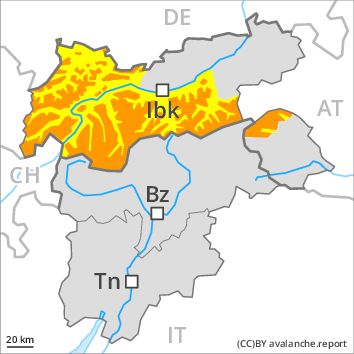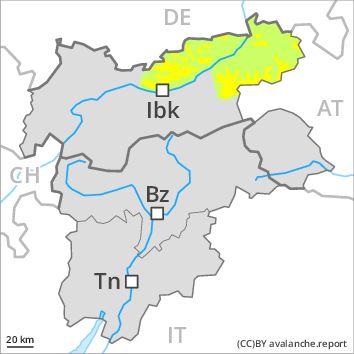Regions
Weißkugel Range, Western Verwall Mountains, Gurgler Range, Eastern Verwall Mountains, Central Stubai Alps, Silvretta, Northern Zillertal Alps, Allgäu Alps, Samnaun Mountains, Venediger Range, Eastern Lechtal Alps - Ammergau Alps, Northern Oetz and Stubai Alps, Mieming Mountains, Western Tuxer Alps, Eastern Tuxer Alps, Western Lechtal Alps, Glockturm Range, Central Lechtal Alps, Grieskogel Mountains

Danger level
Danger Level 3 - Considerable above 2200m
Danger Level 2 - Moderate above 2200m
Avalanche Problem
Wind-drifted snow above 2200m, N-NE-E-SE-S-SW-W-NW
Persistent weak layer above 3000m above 2400m, N-NE-E-W-NW

Wind slabs and weakly bonded old snow at high altitude.
The fresh wind slabs can be released by a single winter sport participant in some cases in particular on very steep shady slopes above approximately 2200 m. Caution is to be exercised adjacent to ridgelines. These avalanche prone locations are clearly recognisable to the trained eye. The avalanches are rather small.
Weakly bonded old snow requires caution. Avalanche prone locations are to be found in particular on very steep west, north and east facing slopes between approximately 2400 and 3000 m. Caution is to be exercised in particular at transitions from a shallow to a deep snowpack in little used backcountry terrain. Avalanches can be released, in particular by large loads and reach large size in isolated cases.
In addition a certain danger of gliding avalanches exists. This applies on steep grassy slopes below approximately 2400 m.
Below the tree line a low avalanche danger will be encountered over a wide area.
Snowpack
dp 6: cold, loose snow and wind
dp 7: snow-poor zones in snow-rich surrounding
Faceted weak layers exist in the old snowpack, in particular between approximately 2400 and 3000 m.
The sometimes storm force wind has transported some snow. The fresh wind slabs are in some cases prone to triggering in particular on very steep shady slopes above approximately 2200 m.
The wind slabs of the last few days have bonded quite well with the old snowpack.
The snowpack will be subject to considerable local variations.
Tendency
Gradual decrease in avalanche danger.
Regions
Glockner Range, Eastern Deferegger Alps, Schober Mountains, Lienzer Dolomites, Eastern Rieserferner Mountains

Danger level
Danger Level 2 - Moderate above 2200m
Danger Level 1 - Low above 2200m
Avalanche Problem
Wind-drifted snow above the treeline, N-NE-E-SE-S-SW-W-NW

Fresh wind slabs represent the main danger.
Fresh wind slabs are to be evaluated with care and prudence. The avalanche prone locations are to be found in particular on very steep slopes above approximately 2200 m, especially in gullies and bowls, and behind abrupt changes in the terrain. These places are clearly recognisable to the trained eye. Mostly the avalanches are small.
Individual avalanche prone locations for dry avalanches are to be found also on extremely steep shady slopes at high altitudes and in high Alpine regions. This applies in areas where the snow cover is rather shallow. Avalanches can be released, mostly by large loads in isolated cases and reach medium size.
In steep terrain there is a danger of falling on the hard snow surface.
Snowpack
dp 6: cold, loose snow and wind
The strong wind has transported some snow. The fresh wind slabs are in some cases prone to triggering above approximately 2200 m. These are mostly small. In very isolated cases relatively hard layers of snow are lying on old snow containing large grains. This applies especially on shady slopes at high altitudes and in high Alpine regions. The snowpack will be subject to considerable local variations.
Tendency
The avalanche danger will persist.
Regions
Karwendel Mountains, Brandenberg Alps, Western Kitzbühel Alps, Wilder Kaiser Mountains - Waidring Alps, Eastern Kitzbühel Alps

Danger level
Danger Level 2 - Moderate above 2000m
Danger Level 1 - Low above 2000m
Avalanche Problem
Wind-drifted snow above 2000m, N-NE-E-SE-S-SW-W-NW
Persistent weak layer above 2400m, N-NE-NW

Fresh wind slabs represent the main danger.
As a consequence of fresh snow and a strong to storm force wind, mostly small wind slabs formed, caution is to be exercised in particular on shady slopes as well as adjacent to ridgelines and in gullies and bowls in particular above approximately 2000 m.
Weakly bonded old snow requires caution. This applies in particular on very steep shady slopes on wind-loaded slopes. The avalanches are rather small and can be released by large loads.
In addition a low (level 1) danger of gliding avalanches exists.
Snowpack
dp 6: cold, loose snow and wind
dp 4: cold following warm / warm following cold
The sometimes strong wind has transported some snow.
Faceted weak layers exist in the old snowpack in particular on shady slopes. The snowpack will be subject to considerable local variations.
Tendency
Gradual decrease in avalanche danger.



